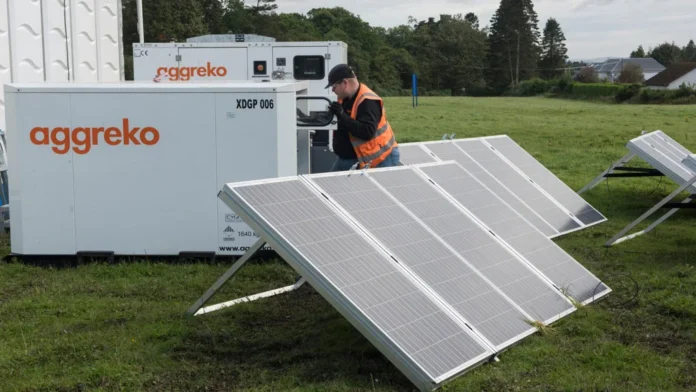With decarbonisation at the forefront of miners’ agendas, the world’s leading provider of mobile and modular power solutions, Aggreko, has released top energy tips to help miners decarbonise now and into the future.
Aggreko’s Global Head of Mining, Rod Saffy, said while miners were embracing the global energy transition, some were unsure where to begin.
“For some miners it’s about knowing where to start and they may be weighing up the cost, risk and threat of new technology in the future,” Mr Saffy said.
“Fortunately, technology isn’t in the same place as it was five years ago or even two years ago. Some of the renewable power technologies available today, combined with thermal generation in a hybrid solution offer the same – if not better – levels of reliability and competitiveness than traditional thermal technology.”
Mr Saffy said power generation companies were taking significant steps to support miners on their respective paths to net-zero emissions.
“Increasingly, power companies are offering renewables such as solar and wind energy to off-grid mines, and we often integrate those with battery storage solutions and thermal microgrids,” he said.
“If you consider a hybrid power solution – where you switch in renewables to your power mix alongside fossil fuels – your operation will be more flexible and can scale up and down as needed.
“Our approach means miners can also partner with us long term without being tied down to one fuel type for their power source, and new technology is introduced as it becomes viable.
“Integrating renewables in this manner will result in greater cost-savings and efficiencies for your project.”
One solar and thermal hybrid solution Aggreko delivered for a remote gold mine in Africa resulted in more than 12% savings in fuel (about 10,000 litres a day) and the contract offered meant the miner did not have to come up with capital to invest in the solar plant. Another example Aggreko was working on, Mr Saffy said, was a hybrid solar and thermal power solution for the Salares Norte open pit mine in Chile.
“It is a ground-breaking solution designed to provide power for the entire mine, which sits at an altitude of 4,500m in the Andes mountain range and is 190km from the nearest town,” Mr Saffy said.
READ: Botswana launches tenders for two thermodynamic solar power plants
“Once complete the hybrid power plant is expected to achieve $7.4 million in cost of energy savings over the next decade a further $1.1 million in carbon tax offset over the life of the mine, in addition to 104,000 tonnes of carbon emissions savings.
“The system will surpass the Chilean government’s environmental standards as well as Gold Fields’ requirement for a minimum of 20% renewable power generation for mining operations.”
Mr Saffy said the pathways to decarbonisation that held the most appeal for miners currently included:
- Hybrid power plants (as mentioned): These combine renewables (e.g., solar, wind) with thermal generation and battery storage, benefiting areas with limited or no access to permanent power. These are generally cost-competitive. Once solar or wind plants are installed, their generation running costs are relatively low and at zero emissions.
- Virtual gas pipelines: Gas power generation offers a greener and more cost-effective alternative to diesel and heavy fuel oil. A virtual pipeline is a substitute, and an alternative, for a physical pipeline. Gas is instead transported as LNG or CNG to the point of use by sea, road, or rail. For mines not connected to a physical pipeline and looking to switch to gas from diesel, a virtual pipeline model simply imitates their current supply solution. For users who are connected to a gas pipeline but are looking to supplement insufficient or unreliable pipeline capacity, the virtual power plant solution has several advantages over diesel.
- Renewable energy: Renewable energy power systems are an effective way of tapping into natural resources to provide power, such as wind farms, hydro power and solar. The challenge is their reliability on weather, hence why if power is interrupted for any reason it is important to ensure they’re backed by with batteries or a temporary thermal power solution.
A significant future fuel in this space will be hydrogen. Investment in hydrogen is on the rise too because of the role it can play in supporting a global transition to net-zero. Its versatility and compatibility with existing furnaces, engines and generators make it particularly appealing for the mining industry. Businesses around the world are at the beginning of their hydrogen journeys and need to be supported to find the best ways of integrating it into their operations.
Mr Saffy said energy sources likely to become more prevalent in mining during the next 10 years included biofuels (would become less expensive), hydropower, energy storage (such as pumped, mechanical flywheel), and gas generation which runs with a hybrid renewable system. While it is increasingly utilised now as power source, wind and solar power is expected to gain more momentum.
Aggreko is also experimenting with mobile wind solutions, re-deployable solar panels and tidal wave power (though tidal wave power might not be for the mining industry yet). The company is also accelerating its investments in hydrogen technology. Trials are underway in Europe on two different technologies, where Aggreko is collaborating with lead customers and partners trialing hydrogen generators and fuel cell battery hybrids.
“It’s a very exciting time in the mining sector, and it will be amazing to see the innovations presented during the next few years as miners and energy companies collaborate and come up with new ideas for a greener future,” Mr Saffy said.
“The key though is to start now – you can embrace renewables now into your energy mix because, done correctly, cost and emission savings can be greatly reduced without compromising reliability.”
Aggreko has its own net-zero goals by 2050 and has a 2030 target to reduce diesel use in its customer solutions by 50%.



